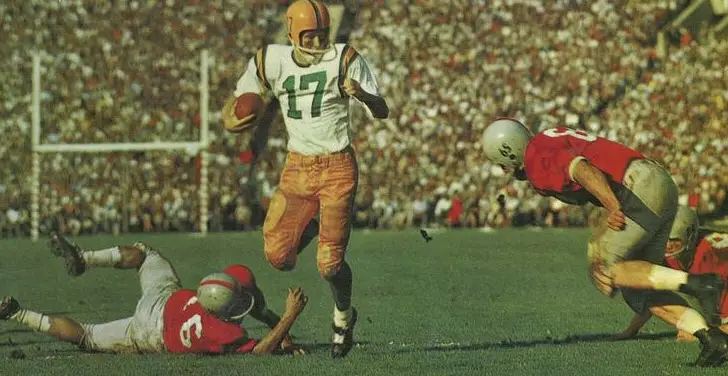The 1957 Oregon Webfoots were an unlikely conference champion, the scrappy ugly ducklings that overachieved proving the nation to not underestimate Oregon. Decades later, Oregon would have an encore of this in eerily similar circumstance and comparable results, but the country would never again take Oregon lightly thereafter.
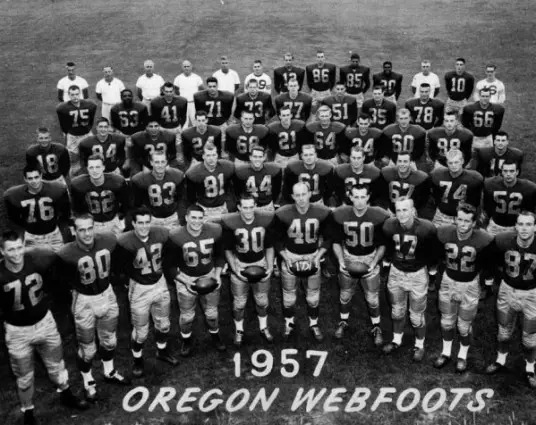
The 1957 Oregon Webfoots overachieved and earned national respect for their play in the 1958 Rose Bowl. Photo Courtesy: Special Collections & University Archives: University of Oregon Libraries
The Pacific Coast Conference was owned by the state of Oregon that year, though few expected it, with both Oregon and OSU having only one loss each on the year going into the Civil War. However, Oregon had already clinched the right to represent the PCC in the Rose Bowl over Oregon State thanks to the previous week’s victory over USC because at the time there was a “no repeat” clause, which left Beaver fans grumbling when OSU defeated Oregon in the 1957 Civil War 10-7, yet it was Oregon that was Pasadena-bound.
The game, in typical Civil War fashion, was not without great controversy, as Oregon halfback Jim Shanley dove for a touchdown as time expired, but the referees ruled that he had fumbled just prior to crossing the line. Despite Oregon State claiming the PCC title, the Ducks headed south for winter for their first trip to the Rose Bowl since 1920.
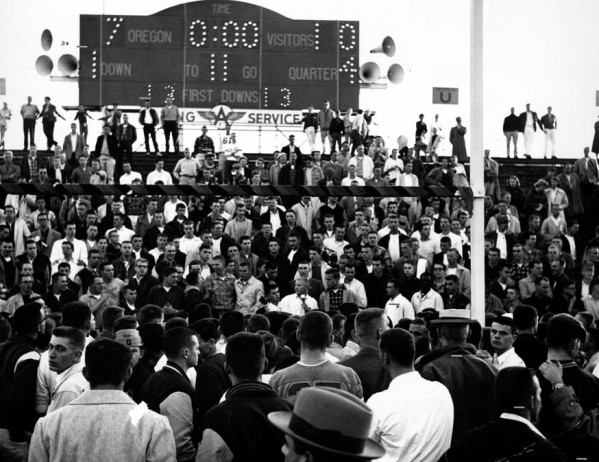
Despite losing the Civil War, Oregon received the invite to the 1958 Rose Bowl because of the PCC’s ‘No-Repeat” clause. Photo Courtesy: Special Collections & University Archives: University of Oregon Libraries
37 years later, another Oregon Ducks team in 1994 would improbably fight their way through the Pac-10 conference schedule, finding themselves conference champions playing in the Rose Bowl following the blueprint set in 1957, led by a coaching staff that included defensive line coach Joe Schaffeld, who had played for the Ducks in the game in ’57.
It hadn’t been easy getting to the Rose Bowl in 1957 or 1994, nearly every game was a close battle with some odd circumstances coming down to the wire. In 1957 in the second week of the season Oregon had led Pittsburgh 3-0 until the final 20 seconds when quarterback/cornerback Jack Crabtree gave up a long touchdown pass over the top that resulted in a heartbreaking 6-3 loss. 37 years later, an embarrassing blowout loss to Hawaii got Oregon’s season off to a very rough start. For both the 1957 and 1994 Oregon teams, their ugly starts gave little confidence that either would play any factor in the conference standings that season.
In 1957 against Washington State, a dog ran onto the field just as WSU was about to kick the game-winning field goal, distracting the kicker just enough to miss wide resulting in a 14-13 Oregon victory.
Big wins over UCLA, San Jose State, and Cal were balanced out with a string of close nail-biters against Idaho, Pittsburgh, Stanford Washington, USC, and OSU. Oregon was winning its games, but it wasn’t aesthetically pleasing, more of a blue collar by-any-means-necessary approach scrapping and clawing out tough victories.
The team was led by quarterback Jack Crabtree, brother of Tom Crabtree, who had been the quarterback at Oregon the previous two seasons.

Oregon head coach Len Casanova, assistant coach John McKay, and Oregon QB Jack Crabtree. Photo Courtesy: Special Collections & University Archives: University of Oregon Libraries
Crabtree had a wealth of running backs to give the ball to, including speedy fullback Jack Morris, who would go on to a 4-year career in the NFL, the elusive Willie West, and Jim Shanley, who finished the year with 693 yards making him the all-time career leader in rushing yards at Oregon. Shanley along with guard Harry Mondale were both named to the All-Coast Conference team, but much like in 1994 when Oregon would next return to the Rose Bowl, few had anticipated that this underdog group of also-rans had any legitimate shot to compete alongside the powerhouses of the day USC, UCLA, Washington, and Oregon State.
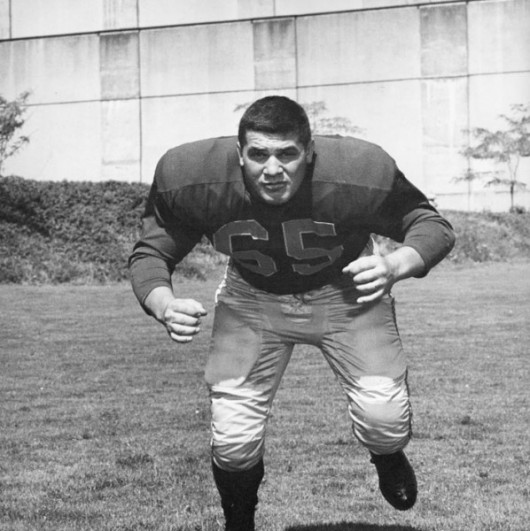
Harry Mondale was one of two All-Conference players for Oregon in 1957, but he was injured on the third play of the 1958 Rose Bowl, making Oregon’s task to compete with the Buckeyes that much harder. Photo Courtesy: Special Collections & University Archives: University of Oregon Libraries
The task was thought to be impossible, to simply hang with the top-ranked Ohio State Buckeyes in the Rose Bowl. Almost nobody thought Oregon had any chance whatsoever to win. Yet Oregon’s run to the roses had been impressive and had moments that turned heads, including Oregon’s 21-0 shutout victory over UCLA and a 16-7 victory over USC where fullback Jack Morris had run for 212 yards.
Ohio State was ranked #1 in the coaches poll and #2 in the AP poll behind Auburn, though the Tigers were on probation due to recruiting violations and ineligible to participate in post-season play. The Buckeyes, stacked with a roster of All-Americans and future NFL hall of famers, were widely considered the top team in the nation.
Oregon may have been lacking in superstars, but it was a collective effort struggling to earn victories through sheer will that came to define the 1957 Webfoots, a blueprint that also defined Oregon in the coming decades, particularly the 1994 team that followed in the 1957 team’s footsteps to face a team in Penn State that most agreed should have been national champions.
In fact the parallels between the 1957 Oregon team and 1994 team are stunning. Both were led by impressive coaching legends that define Oregon’s proud past, Len Casanova and Rich Brooks. Both started off the season with tough out-of-conference losses and were not expected to compete for the league title. Both teams lacked superstar names or great size/speed/athleticism that was thought to be able to consistently compete with the best teams in the nation. It had been 38 years since Oregon played in the Rose Bowl when the 1957 team made it, for the 1994 team it was 37 years. In 1957 Oregon faced a Big-10 coaching legend in Woody Hayes, in 1994 it was the only Big-10 coach who could surpass the immense shadow of Hayes’ legacy, Joe Paterno.

The Oregon Ducks team in 1994 was the first to return to the Rose Bowl since the 1957-58 Oregon Webfoots
What they may have lacked in stature on the surface, both the 1957 and 1994 Oregon teams made up for by perfecting the art of football synergy, working together to overcome their flaws to defeat teams thought far superior that year to improbably make a run to the Rose Bowl. The 1957 team was the first Oregon squad that defeated all four California schools in a single-season, the 1994 team didn’t play UCLA but defeated the other three. This straight sweep of all California schools would not be accomplished again by an Oregon team until the perfect 12-0 regular season Oregon had in 2010 on its way to the national championship game.
The 1957 team featured a string of unlikely victories over highly ranked opponents like USC and UCLA to propel Oregon to the Rose Bowl. The same could be said 37 years later, when Oregon’s 1994 team defeated USC, Washington, and Arizona in games where it seemed unfathomable that the Ducks could defeat such powerful teams.
The 1957 co-national champion Ohio State Buckeyes boasted a stacked roster of All-Americans including Jim Marshall, Joe Cannavino, and Dick Lebeau. 1994 Penn State was led by multiple All-Americans and NFL stars, including Kerry Collins, Kyle Brady, Bobby Engram, and the #1 overall NFL draft pick Ki-jana Carter.
In both 1957 and 1994 it was considered a laughable David vs. Goliath matchup, no self-respecting sports writer in the country giving Oregon any legitimate shot…why should they? In 1957 Oregon had made it to the Rose Bowl over Oregon State because of a no repeat-clause, not because they were the best team in the conference as decided on the field, and in 1994 it was thought a fluke that Oregon was there, while Penn State was consensus #1 in the country for much of the season.
The common thread among news stories of the day in 1957 was that this would be the most mismatched game in the 44-year history of the Rose Bowl, and that Oregon didn’t even deserve to be on the same field as the Buckeyes.

The 1958 Rose Bowl was considered one of the biggest mismatches in the game’s history, but the game played out much differently from expectations
Len Casanova’s team didn’t look the part of a great football team, nicknamed “The Ugly Ducklings.” What Oregon lacked in overall talent, they made up for in competitiveness and grit. Never underestimate the motivation of a defiant group being told they shouldn’t even show up or they will be laughed out of the building.
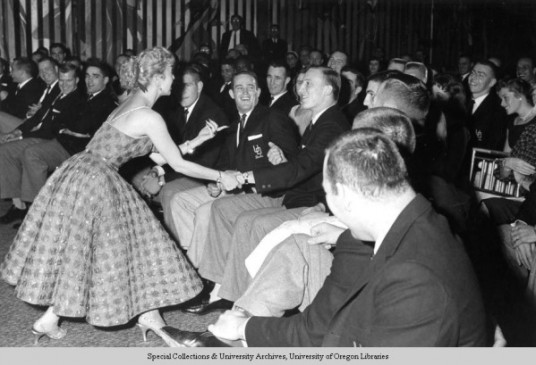
WR Ron Stover says it’s HB Jim Shanley that she wants, at an event in Hollywood before the 1958 Rose Bowl. Photo Courtesy: Special Collections & University Archives: University of Oregon Libraries
Oregon had two foes to overcome in the game, Ohio State and the media. They had a new determination, win or lose they wanted to make the papers look bad. While Ohio State may not have considered Oregon much of a foe, they and the doubters found out quickly that they were in for a battle on January 1st, 1958 at the Rose Bowl in Pasadena, CA.
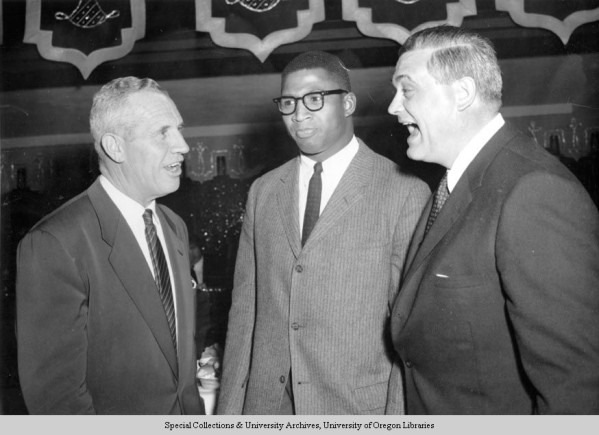
Oregon coach Len Casanova, Ohio State guard Aurelius Thomas, and OSU coach Woody Hayes at an event before the 1958 Rose Bowl. Photo Courtesy: Special Collections & University Archives: University of Oregon Libraries
Legends of broadcasting were there that day to cover the game, Keith Jackson covering the radio broadcast while Mel Allen and Chick Hearn handled the television duties for the national television audience. While trying to stay as impartial as possible, even they couldn’t help but subtly predict a slaughter. Ohio State was favored in the game by 19, many thought it should have been more than that.
Oregon showed up surprisingly early for the game, making their way out onto the field nearly two hours before they were scheduled to go through warm-ups, grossly miscalculating the amount of traffic that would be encountered due to the annual Parade of Roses in Pasadena.
Not quite sure what to do, Head Coach Len Casanova told his assistant coaches to take their respective position groups and go relax them, tell some jokes or stories for a while to occupy time. By the time the team returned to the dressing room for pregame preparations, Casanova recognized how loose and ready his team was and asked for simply one thing, “Make me proud today.”
It started as many expected, with Ohio State slowly marching 79 yards for a touchdown to take the lead 7-0, despite solid defense by Oregon it appeared like it would be a long day, the first of many scores for Ohio State that were predicted to follow.
It didn’t help any that Oregon team captain Norm Chapman wasn’t playing, suffering a broken leg vs. Washington State earlier in the year. On the third play of the opening drive things got worse, as Oregon’s All-Conference guard Harry Mondale was injured, forcing backup Joe Schaffeld into the lineup. Schaffeld would hold the line admirably against OSU all game, and years later would become a mainstay at the university of Oregon as the Ducks’ defensive line coach, including the 1994 season when Oregon next returned to the Rose Bowl.
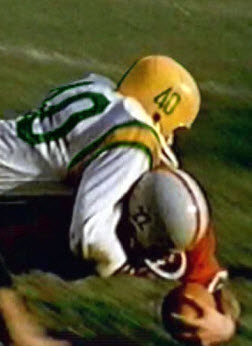
Action in the 1958 Rose Bowl
What happened next though in the 1958 Rose Bowl shocked everyone, except those clad in green & yellow. Ohio State’s predictably traditional Big-10 style 3-yards-and-a-cloud-of-dust offense slowly ground out small chunks of yards at a time, but Oregon was all over the field. Halfback option passes, deceptive quarterback fake jump pass draws, option plays, even a triple reverse pass had Oregon marching up and down the field.
Meanwhile Oregon’s defense, while missing Chapman and Mondale, were stout at stacking the line and putting plenty of pressure on OSU QB Francis Kremblas.
It was a fluke game from many respects. Oregon was dominating the stats, but turnovers kept Ohio State in the game. Oregon’s defense was solid, holding Ohio State’s superstars of the game to short yardage all day except for a couple broken tackles resulting in big gains.
But turnovers took their toll. Despite the yards being racked up, two interceptions by Joe Cannavino and two fumbles stacked the odds further against them. Oregon was winning at the line of scrimmage and with their wide-open playbook, but four turnovers is difficult to overcome regardless of the opponent, three of these turnovers coming in field goal range.
Oregon had a chance to score on one of the strangest fluke plays in the history of the Rose Bowl, when a pitch to halfback Willie West, who then tried to throw, was deflected by an Ohio State lineman into the hands of Oregon offensive lineman Tom Keele, who had been knocked to the ground and was just standing back up to find the ball suddenly in his hands…immediately Keele started sprinting into the open field with only one Ohio State defender between Keele and the endzone, unfortunately in his panic Keele ran directly towards the defender and only managed to pick up a first down.
The score was tied 7-7 at halftime, stunning the audience in the stands and those watching on TV, thanks to a touchdown run by Oregon halfback Jim Shanley.
Nobody expected Oregon to hang with the national champions, but Oregon’s defense had been extremely impressive and the offense with their innovative playbook had OSU on their toes. OSU drove close to a touchdown, but the Ducks held on a 4th down as QB/safety Jack Crabtree leaped over a receiver to bat the ball down.
Each team had split short touchdown runs, but it was Oregon the far more impressive team racking up tons of yards on long plays while Ohio State slowly ground out gains in short bursts with an occasional big run or play-action pass. The Ducks were playing loose, above and beyond what anyone had predicted.
In the 2nd half Oregon had a chance to take the lead with a field goal attempted from the 24 yard line, but Jack Crabtree’s kick unfortunately sailed just wide. In the 4th quarter Ohio State from the exact same spot on the field did successfully hit a field goal, making the score 10-7.
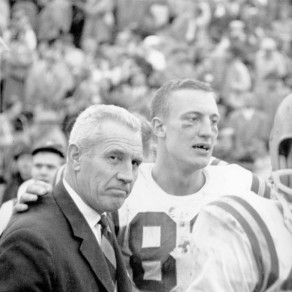
University of Oregon football player Ron Stover with his arm around head coach Len Casanova
Oregon continued to roll up and down the field but failed to execute once within scoring range. Ohio State sitting on 10-7 lead had played ball control, trying to bleed off the clock. However a 4th down stop by Oregon’s defense gave one more chance to tie or win it.
With seconds left in the game Oregon had a chance to win, as wide receiver Ron Stover had a long pass completion putting the Ducks in range to at least tie it with a field goal or go for the victory, but Stover was stripped of the ball as he was going to the ground and fumbled.
Stover had 10 catches in the game, but his final one closed the door on Oregon’s chances. Ohio State ran out the clock, winning the Rose Bowl 10-7.
However, the final score didn’t tell the whole story. Just like 37 years later with the 1994 Oregon football team, just getting there was as much of a victory than the final score, and the valiant efforts of the scrappy Oregon Ducks shocked the world.
It was Ohio State winning the game on the scoreboard, but Oregon Head Coach Len Casanova was the one being carried off the field by his players in celebration.
This would be repeated in the 1995 Rose Bowl, as coach Rich Brooks was carried off in celebration for Oregon’s efforts to end a magical season despite losing to Penn State 38-24.
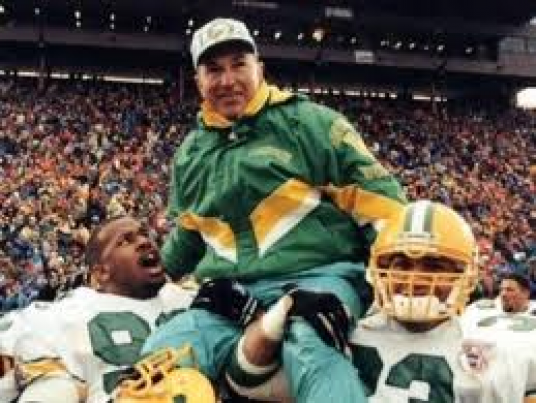
Oregon coach Rich Brooks would be carried off the field by his players in his last two games as Oregon’s coach, against Oregon State (pictured here) and in the 1995 Rose Bowl.
Following the 1958 Rose Bowl, Oregon quarterback Jack Crabtree in a losing effort was named the game MVP, something that again would be repeated by Oregon in 1995 when quarterback Danny O’Neil set a Rose Bowl record with 456 passing yards and was named co-game MVP desspite losing 38-24.
Regardless of the final scores in the 1958 and 1995 Rose Bowl games, both teams turned heads. Little Oregon had competed with the big boys and completely out-shined their favored opponents in every way on the field, yet unfortunately bad luck kept them from winning on the scoreboard as well. What they had failed to earn in the trophy case, the Oregon Ducks earned ten-fold in national respect.
Following the 1958 Rose Bowl the writers who had done everything they could to humiliate Oregon in the press took notice and admitted they were wrong, Oregon had earned the right to compete with anybody.
Ohio State players congratulated Oregon for the way they played, the decidedly larger Ohio State fan base in attendance cheered the Oregon team as they departed the field. Oregon may not have won on the scoreboard, but the Webfoots were victorious in every other way imaginable that day. Most importantly of all, despite the 10-7 loss, the 1957-58 Oregon Ducks had indeed done everything that coach Casanova had asked of them, they had made him proud.
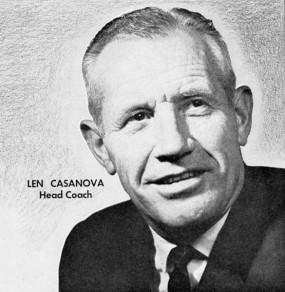
Coach Len Casanova
37 years later after the final seconds of the 1995 Rose Bowl ticked away, and with Len Casanova looking on Oregon Head Coach Brooks would utter similar words in defeat…never was he more proud of a team.
Following the 1958 Rose Bowl Len Casanova remained head coach for years, and eventually became an administrator and mentor for the Oregon Ducks athletic program for decades. He would oversee the construction of new facilities, support the many years under Coach Rich Brooks when it seemed like Oregon has sunk to its lowest point, and be there to show support when Oregon arose from the ashes like a phoenix. The Casanova Center built in 1990 was a launching point, with baby steps being accomplished each season building up the program to
But while hard times for years followed after Oregon’s loss to Ohio State in the 1958 Rose Bowl, the loss in the 1995 Rose Bowl was a turning point for the program. The team followed it up with a 10-2 season and trip to the Cotton Bowl, while with Casanova’s assistance Oregon began expanding and improving its facilities. The Moshofsky Center was built within a few years, Autzen Stadium was expanded, other facilities were added, and suddenly Oregon winning was not a fluke, it was a tradition.
The success Oregon experiences today is built upon the shoulders of those who struggled for decades with minimal facilities and underdog players who achieved in spite of the naysayers. The 1957 Oregon team epitomized the spirit that defined what it means to be a Duck, an ideology mimicked again in 1994 and every year thereafter.
Related Articles:
These are articles where the writer left and for some reason did not want his/her name on it any longer or went sideways of our rules–so we assigned it to “staff.” We are grateful to all the writers who contributed to the site through these articles.

